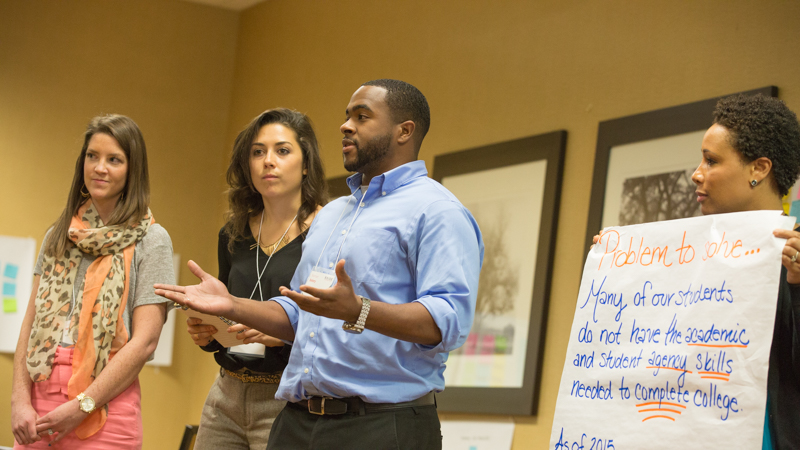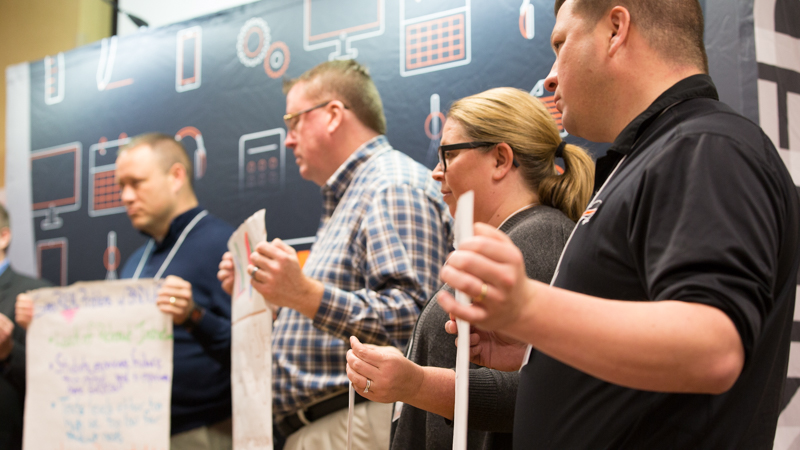For the past year, 75 districts and charters in Texas have focused quietly on a vexing puzzle: how to use technology to jumpstart student achievement, but without wasting dollars on unwise technology bets that never pay off?
These 75 organizations first confronted the puzzle together last summer, when Raise Your Hand Texas, a privately funded organization that advocates for public schools, invited all 1,200 Texas districts to compete for five opportunities to receive up to $500,000 each and intensive technical assistance to implement blended learning.
Raise Your Hand Texas selected the book Blended: Using Disruptive Innovation to Improve Schools as the training manual and CA Group as the implementation leaders for the project.
In the fall, the 75 teams that demonstrated the most interest and readiness met together to begin to draft their blended-learning plans. The best plans that emerged from those workshops, which I designed and facilitated as a consultant to Raise Your Hand Texas, embraced three strategies from Blended to avoid wasting dollars on bad technology spending in schools.
Strategy #1: Start with the problem and goal, not with the technology
Teams were forbidden from even discussing technology until Day 2 of the workshops, and they learned not to hang their hats on being 1:1 schools (see Julia Freeland Fisher’s piece). Instead, they began with a deep analysis of their existing problems at the root of their poor performance. Then they developed goals for how much improvement they planned to make. The goals were SMART—specific, measurable, assignable, realistic, and time-bound.
For example, KIPP Houston, one of the teams that eventually made it to the Top Five, began with this problem analysis:
Currently, only 22 percent of our high school students enroll in AP Calculus or Statistics. To reach AP math without taking double math or skipping courses, students must complete Algebra I in eighth grade. Currently, only 57 percent of our eighth graders do, mainly because they are not academically prepared. Their learning gaps are too disparate for the teacher to remediate in a whole‐group setting.
Then KIPP Houston developed this SMART goal:
By the end of a 60‐hour Algebra Boot Camp during the summer, 90 percent of students will meet their growth goals on the end‐of‐bootcamp assessment using a Flex model where they can learn at their own pace and get remediation/acceleration in order to be prepared for Algebra I coursework in 8th grade. The manager of digital teaching and learning will own this project.
KIPP Houston did not even mention technology until halfway through its blended-learning plan! The team focused first on its problem, goals, and design. Technology played a crucial, but subordinate, role in its plan.
 Photo: KIPP Houston’s team presents its blended-learning plan at the workshop. Photo credit: Raise Your Hand Texas
Photo: KIPP Houston’s team presents its blended-learning plan at the workshop. Photo credit: Raise Your Hand Texas
Strategy #2: Incubate disruptive pilots in areas of nonconsumption
Most of the 75 teams felt attracted to the benefits of a disruptive model of blended learning—an Individual Rotation, Flex, A La Carte, or Enriched Virtual model. These models are natural fits with competency-based learning and maximize student agency. Participants perceived a value in these innovations, particularly for middle and high school students.
The challenge, however, is that when school leaders try to implement a disruptive model with mainstream students in core subjects, the incumbent system resists. Established teachers are reluctant to replace their lesson plans; the facilities, schedules, budgets, and professional development clash with the divergent approach; and the new model is not well-developed enough to generate the student performance results that would merit its continuation.
A wiser strategy is to incubate the disruptive pilot first in an area of nonconsumption—that is, an area where the system is not able to provide service, such as, for example, an afterschool program, summer school, homebound students, advanced courses, foreign languages, test preparation, or electives. These areas provide safe harbor for incubating a disruptive model until it is ready for primetime.
Birdville Independent School District, another of the Top Five, plans to pilot an innovative Flex model at Shannon High School, an alternative high school where at-risk students earn the credits they need to graduate in accelerated quarter terms. Birdville has big plans for this program, including project-based learning, small-group teacher conferencing, and a carefully vetted playlist of adaptive software, to transform the high school experience for this pocket of students. It will use its lessons learned to update its other high schools, once it has mastered the model at the alternative high school first.
 Photo: Birdville Independent School District’s team presents its blended-learning plan at the workshop. Photo credit: Raise Your Hand Texas
Photo: Birdville Independent School District’s team presents its blended-learning plan at the workshop. Photo credit: Raise Your Hand Texas
Strategy #3: Use heavyweight teams to re-architect the system
The third technique that the most successful teams embraced is to use heavyweight teams. A heavyweight team is made up of experts from across an organization who come together to complete a task. Importantly, they leave behind their loyalties to their classrooms or departments and, instead, commit their hearts to the efforts of the heavyweight team for the duration of its project.
Heavyweight teams have the expertise and power they need to re-architect a system. They can retune staffing, facilities, budgets, and curriculum to a new student experience. Too often, however, schools do not leverage heavyweight teams when they undertake so-called “technology integrations.” Instead, they focus on professional development for individual classroom teachers. This PD-focused approach is a key reason that so many blended-learning implementations fail to be transformative. The organization failed to use a heavyweight team to do the upfront work of re-architecting the system.
Moving forward in Texas
Today, five teams are moving forward as demonstration sites for blended learning in Texas, supported by Raise Your Hand Texas funding and CA Group guidance. These include Birdville Independent School District, Cisco Independent School District, KIPP Houston, Pasadena Independent School District, and Point Isabel Independent School District. Raise Your Hand Texas invited 15 other districts and charters to participate in the Raising Blended Learners Pilot Network. All of these systems will receive technical support and collaborate using the Blended Learning Resource Portal, which is open to the public.
With the Raising Blended Learners initiative, Texas is poised to lead the way in demonstrating how to transform an old system into student-centered learning at scale. As Texas catalyzes transformation across its 1,200 traditional districts, other states will have an example for how to embrace the benefits of 21st-century technology without wasting money on bad bets.

